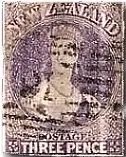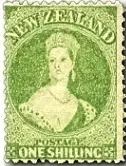Definitives Tour.
Links:- Full-Faced Queens.
1855 Full-Faced Queens - Part One.
A basic introduction to the Full Faced Queens issues.
1855 Full-Faced Queens - Part Two.
Looking at factors affecting the condition and value of Classic Stamps.
1855 Full-Faced Queens - Part Three.
A collection of covers from before and using Full Faced Queen stamps.
1855 Full-Faced Queens - Part Four.
Modern use of the Full Faced Queen design.
What better way to start this blog again than to feature New Zealand's first issue of postage stamps, The Full-face Queens. This post is only an introduction to this set. I plan to do a page or some further posts on the Full-face Queens at a later date. (Links to these pages have now been added above.)
Following the example of Great Britain, which first introduced postage stamps in 1840, New Zealand decided to introduce a system of pre-payment of postage using similar stamps in 1850. It would take another five years before these new stamps were finally issued.
The set originally comprised only three stamps - 1d (penny), 2d (penny) and 1s (shilling). These were printed in England by Perkins, Bacon. Other values were added later. The 6d appeared in 1859, the 3d in 1863 and the 4d in 1865. These additional values, together with all reprints of the original three denominations, were printed in New Zealand from printing plates prepared in England. Colour changes were made to three of the values in 1871. The 1d changed from red to brown, the 2d from blue to orange and the 6d from brown to blue. I have also seen examples of the 1s which appear bluer than the usual green.
1d Orange. 2d Blue. 1s Green.
The first stamps in this series were not perforated, as can be seen above, and needed to be hand cut from full sheets. These are known as the Imperforated Full-face Queens. Perforating trials were undertaken in the early 1860s, both official and unofficial, using various processes. The first official perforating was done in Auckland in 1864 which began the second period of the Full-face Queen issue known as the Perforated Full-face Queens, as can be seen below.
1d Red. 1d Brown. 2d Blue. 2d Orange.
3d Lilac. 4d Yellow. 4d Red.
6d Brown. 6d Blue. 1s Green.
To design of these stamps, Edward Corbould completed a watercolour sketch of Queen Victoria based on a portrait by Alfred Chalon. The Chalon painting depicted a young Queen Victoria in her State Robes at the time of her coronation. The painting appeared on a miniature sheet issued by New Zealand in 1988 to mark the Centenary of the Royal Philatelic Society.
Even today these stamps are sometimes known as the 'Chalon Queens' although I believe this term could be confusing for newer collectors.
Well, that should give you an introduction to this classic series of stamps.
Interesting Note.
It has been brought to my attention that the Full-faced Queen design might not be based on this painting above. There is a comment in the comment section below. Follow the link its an interesting read.
Interesting Note.
It has been brought to my attention that the Full-faced Queen design might not be based on this painting above. There is a comment in the comment section below. Follow the link its an interesting read.
Technical information
Date of issue:
| 18 July 1855 |
|---|---|
Designer:
| William Humphrys |
Printers:
| Perkins, Bacon, England; J Richardson, Auckland, New Zealand; J Davies, Office of the Postmaster-General, Auckland, New Zealand and Government Printing Office, New Zealand |
Stamp size:
| 21mm x 28mm |
Sheet size:
| 240 stamps per sheet |
Process:
| Recess printed - Intaglio |
Perforation gauge:
| The first stamps in this series were not perforated. Trials were undertaken in the 1860s, both official and unofficial, using various processes. |
Paper type:
| Various paper types |
Some of the images in this post were used with permission from the illustrated catalogue of StampsNZ
You can visit their website and On-line Catalogue at, http://stampsnz.com/
Information for this post came from.



















Your blog is such a great resource and I really love it!
ReplyDeleteAllow to raise one minor issue: certainly the historical literature identifies the Corbould miniature as an important step on the journey from Chalon portrait to New Zealand FFQs, yet this has been challenged by more modern scholarship. For a summary, please take a look at hartstamps.blogspot.com/2019/04/so-what-did-corbould-contribute-to-new.html.
But this is just a detail: kudos and thanks again to the virtualnewzealandstamps team!
Ok thanks, we will follow this up.
DeleteGreat post thanks :)
ReplyDeleteCould you explain how the 4d rose colour came to be printed? And I have also seen reference to a 4d orange - is it a valid issue?
We appreciate your engagement with our content. To ensure a respectful and constructive community, please take note of the following:
- No Spam, Please: We do not tolerate spammy or promotional comments. Any such comments will be promptly removed.
- Moderation in Place: All comments are moderated to maintain a positive and inclusive environment. Please be patient, as it may take a little time for your comment to appear.
- Sign In with Google: To comment, please sign in using your Google account. This helps us maintain the integrity of our community and allows for better interaction.